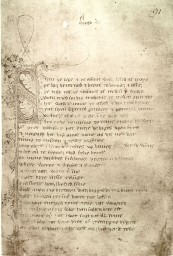RETROSPECTIVE: Sir Gawain and the Green Knight by Anonymous (author) Jessie Weston (translator)
Friday , 22, August 2014 Book Review 3 Comments Are spoiler alerts necessary for something that was written in the 14th century? In the case of Sir Gawain and the Green Knight, with its twist ending and potential appeal to modern fantasy readers, the answer is a definite yes. So this review will stay away from the spoilery stuff.
Are spoiler alerts necessary for something that was written in the 14th century? In the case of Sir Gawain and the Green Knight, with its twist ending and potential appeal to modern fantasy readers, the answer is a definite yes. So this review will stay away from the spoilery stuff.
In my previous post, we briefly discussed the malady known as chronocompulsive obsessive disorder (COD) – the peculiar need of certain readers to start a series at the earliest possible beginning of the work, including its influences (and the influences of those influences). Modern fantasy has a rich tradition of such influences, so being chronocompulsively obsessed and a fan of faerie can lead to sleepless nights thumbing through tedious archaic texts, or sleepless nights thumbing through great archaic texts like Sir Gawain and the Green Knight. Perhaps the remedy is realizing that the fantasy genre – or any genre and individual work of fiction – doesn’t have ancestors. There is no beginning to find, because the literary process is not strictly genealogical. Corey “The Tolkien Professor” Olsen, comments on this phenomenon in the first lecture of his Faerie course:
“The modern fantasy genre [is] in a sense a child of these old faerie story traditions. I say in a sense because I want to be careful. One word that I’ve been trying carefully not to use in talking about this is evolution, because I think that gives a misleading sense of things. I think it’s not quite fair to say that the modern fantasy genre devolved out of the old faerie story genre, because I don’t think that metaphor—the evolution metaphor—is a very good one for the actual process that we see. Rather…what we can see is that these are different manifestations of this same kind of impulse at different times. And they’re aware, often, of previous traditions, but I don’t think we can quite say that one grows out of the other…in a sort of genuinely evolutionary mode.” (Emphasis added)
Rather than focus pedantically on fantasy’s family tree, we should focus on fantasy’s muse. Both Joe Abercrombie and the anonymous poet of Sir Gawain are following the same muse, but to wildly different results. What’s consistent are the florid depictions of decapitation. Check this out (it’s even better in the Middle English):
“Gawain gripped his axe and raised it on high, the left foot he set forward on the floor, and let the blow fall lightly on the bare neck. The sharp edge of the blade sundered the bones, smote through the neck, and clave it in two, so that the edge of the steel bit on the ground, and the fair head fell to the earth that many struck it with their feet as it rolled forth. The blood spurted forth, and glistened on the green raiment.”
See, this tale is too cool to focus on frivolities. It’s a classic quest story where the quest in question centers on the hero’s journey to get his head chopped off. In other words, not your archetypal fantasy MacGuffin. The screenwriting blogger over at Cockeyed Caravan talks about how a story has dramatic irony when the plot-at-hand is not only hard for the hero to do, but hard for the hero to want to do. Needless to say, Sir Gawain has some internal conflict about accomplishing this mission, but being a man of honor is duty bound to follow it through to the bloody end.
This is an Arthurian fantasy story that is a pleasure to read even for modern eyes. There are genuine moments of humor; from Arthur’s quip following the Green Knight’s marvelous appearance to the way that Gawain turns down the smoking hot (and very much married) temptress. Gawain manages to be a complex character, even as he embodies all the knightly virtues. Though by the end the plot turns out to be illogically contrived, the focus is really on Gawain’s broken psychology, which leaves the reader in a sad but satisfying kind of limbo. The alliterative poetry is obviously great, and though I am by no mean an expert in medieval literature, Weston’s translation was also easy-to-read. Do get your hands on an edition with both the modern translation and the original Middle English text though; this edition only had the former.
If you suffer from chronocompulsive obsessive disorder and are a fan of fantasy, you can find no better beginning than this one.
10/10
Didn’t Tolkien wrote a book regarding this same story, Sir Gawain and the Green Knight?
Also, what? Did Gawain chopped off his own head?!
-
Tolkien did a new translation of the story.
And no, Sir Gawain did not chop off his own head. Self-decapitation with an ax is nigh impossible, and considering the length of the ax in question, he would have been hard pressed to gain enough momentum. Not to mention that it’s not a very knightly thing to do.
-
Thanks for the link, and thanks too for the correction, I mistakenly equated “hero’s journey to get his head chopped off” with “Sir Gawain has some internal conflict about accomplishing this mission”.
-